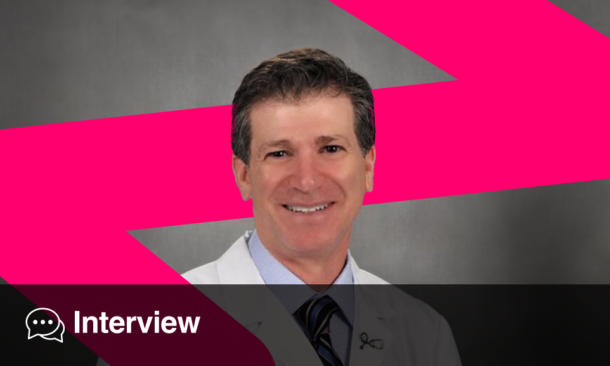Speakers: Antonis Pantazis,1,2
1. Royal Brompton and Harefield Hospitals, London, UK
2. Department of Cardiology, North Middlesex University Hospital National Health Foundation (NHS) Trust, London, UK
Disclosure: Pantazis is an advisor for BMS, Cytokinetics, and Teneya.
Acknowledgements: Medical writing assistance was provided by Jennifer Taylor, London, UK, and supported by Hannah Moir, Senior Medical Writer, EMJ, London, UK.
Support: The medical education podcast and publication of this article were sponsored by Myokardia Inc., a wholly owned subsidiary of Bristol Myers Squibb.
Disclaimer: The opinions expressed in this article belong solely to the named interviewee.
Citation: EMJ Cardiol. 2022;10[Suppl 8]:2-6. DOI/10.33590/emjcardiol/10168110. https://doi.org/10.33590/emjcardiol/10168110.
Interview Summary
Antonis Pantazis, Consultant Cardiologist at the Royal Brompton and Harefield Hospitals and North Middlesex University Hospital in London, UK, and Chairperson of the European Society of Cardiology (ESC) Working Group on Myocardial and Pericardial Diseases, provided an expert insight into the various aspects of obstructive hypertonic cardiomyopathy (HCM) during an EMJ- conducted podcast.WHAT IS HYPERTONIC CARDIOMYOPATHY?
Obstructive HCM is a condition in which the heart has thickened walls that are not caused by blockage of the heart valves or by very high blood pressure.1 For the majority of patients, the cause of their disease has a genetic basis and is hereditary.1 A genetic test can diagnose HCM in some patients, but the results are inconclusive in others.2 It is important to note that the results of a genetic test need to be carefully interpreted by geneticists and clinicians, in the context of the patient’s clinical condition, before being used for further management of the patient and their family.2
HCM is diagnosed in between one in 200 and one in 500 people.3 The condition can worsen over time, with the heart becoming enlarged, resulting in several complications due to cardiac hypertrophy, which may present years after the initial diagnosis.4 HCM is a chronic disease that requires monitoring over time, as treatment may need to be modified or increased at different stages of the clinical course and risks may be identified and need to be prevented.1
SYMPTOMS AND DIAGNOSIS
Patients with HCM usually complain of chest pain, breathlessness, and palpitations.1,5 Some patients also experience fatigue, dizzy spells, and even loss of consciousness.1,5 The symptoms of HCM can overlap with other conditions.6 For example, patients with asthma can present with breathlessness; therefore, it may be difficult to reach a definitive diagnosis, at least in the early stages of HCM.7
No specific tell-tale symptoms of HCM differentiate it from other conditions. Clinicians must consider the clinical context such as the patient’s age, the presence or absence of relevant family history, and other clinical details that may help with the diagnosis.1 Clinical awareness is also very important. Pantazis observed that it is more likely that HCM will be diagnosed if clinicians have the disease in mind as a possibility, as it may remain undiagnosed for several years if not.
A number of tests can be performed to diagnose HCM, and the usual starting point is an ECG,8 especially if they have chest-related symptoms.1 If the ECG is abnormal, then further tests are arranged.1 These typically include imaging of the heart such as an echocardiogram, and may include a Holter monitor to record the heart’s rhythm.9 More sophisticated imaging of the heart may also be performed, namely cardiac MRI and exercise stress test.9
Pantazis indicated that a diagnosis of HCM can be missed, particularly if it is not among the possible conditions under consideration. The presence of other health conditions can also make it challenging to obtain a diagnosis. For example, if a patient has high blood pressure, mild enlargement of the heart, and thickening of the walls of the ventricles, the diagnosis might be assumed to be hypertensive heart disease rather than HCM.7
Currently, in the UK, a diagnosis of HCM is generally achieved, but there may be delays in some cases. Once a patient is diagnosed with HCM, their family is screened for the condition with the aim of diagnosing additional cases early and initiating preventative treatment.10 The process for family screening starts with general practitioners, who may refer relatives to a district general hospital or tertiary centre, according to where it is most convenient for relatives to attend an appointment.10
TYPES OF HYPERTONIC CARDIOMYOPATHY
There are two types of HCM, and these are referred to as nonobstructive and obstructive.11 In nonobstructive HCM, one of the walls of the heart is thickened and may be stiff, but this does not block the flow of blood out of the heart. However, obstructive and nonobstructive HCM have overlapping features.
In obstructive HCM, the thick wall of the heart together with one of the valves blocks the exit from the heart, known as the left ventricular outflow tract, during systole.9,12 The situation is dynamic, meaning that it may not occur during every systole. Blockage does tend to occur when the heart is making more effort to pump blood out, typically during exercise.13
AGE AT DIAGNOSIS
HCM can be diagnosed at any age, but Pantazis explained that, for a number of reasons, it is more frequently diagnosed at a relatively young age.14,15 One of the reasons is that, in younger people, there are generally no lung diseases or other heart conditions that could explain the patient’s symptoms. If a young person is suddenly breathless or experiencing chest pain, they will be fully investigated because this is unexpected. In contrast, if a 70-year-old patient experiences breathlessness or chest pain, it might be explained by the patient’s age, lack of fitness, being overweight, or other conditions.
Late-onset HCM also occurs when patients present in their teenage years, young adulthood, or even middle age. In some cases, symptoms are not particularly limiting, and patients may have the condition for several years without seeking medical attention or being diagnosed.1
TREATMENT OPTIONS
There are currently no medications that have been specifically developed for HCM. Medical therapy aims to treat symptoms, if present, and reduce the risk of complications such as sudden death.1 Treatment options include medical therapy and surgery.16 The reality is that medication is ineffective at lowering the likelihood of all complications and is used primarily to treat symptoms.7,17 Because there is an obstruction to cardiac output in some patients with HCM, negative inotropic agents are commonly used to relax the heart and prevent it from beating vigorously.17,18 Experience has shown that some of the symptoms can be alleviated; however, the downside is that these medications may also affect the whole body. Therefore, the price patients pay for a medication that relieves their chest pain is feeling tired as a side effect of the drug. They may also experience other side effects. Furthermore, medications do not address the underlying mechanisms of the disease and do not stop the progressive thickening of the heart muscle.
A surgical procedure, called myectomy, is another treatment option and is considered the gold standard treatment for obstructive HCM, provided the patient has no contraindications.19-21 Myectomy corrects the anatomic abnormality inside the heart, preventing obstruction and restoring the heart’s function. The procedure needs to be planned and tailored to the mechanism of obstruction and other abnormalities of the heart in each individual patient.21 HCM is a complex disease that affects not only the septum, which is usually more hypertrophied than the rest of the heart, but also the function of the mitral valve. Therefore, surgical myectomy typically involves reducing the thickness of the septum and may include the removal of cardiac muscle beneath the mitral and aortic valves to restore normal ventricular function. The procedure is complicated and demanding, with the surgeon accessing the heart via the aortic valve.22 However, in experienced centres, the mortality rate is less than 1%, which means this is a safe operation, provided it is offered to the appropriate patients.23
Given the technical challenges of cardiac myectomy, the complexity of the cardiac condition, and the fact that training for myectomy is not simple, the operation is offered only in a small number of centres.21 This limited experience worldwide means that only a small number of patients have access to a hospital that performs this procedure safely and with good success rates, making this an unmet need internationally.24
As for which patients are most in need of a myectomy, there are treatment guidelines published by the ESC and the American Heart Association (AHA)/American College of Cardiology (ACC),9 but, unfortunately, they cannot advise on the best course of action for individual patients. This is because every patient with HCM, and more particularly obstructive HCM, has a slightly different heart. In this condition, each individual patient and each individual heart needs to be studied carefully so that personalised treatment decisions can be made.21 For this reason, the best practice is to make decisions in multidisciplinary team meetings, where specialists with different expertise and experience meet to discuss cases and make a joint decision.1
Patients who do have a myectomy commonly provide positive feedback,25 even in the early postoperative days when they may still be experiencing pain from the operation itself. Often, patients report that all of their previous symptoms have disappeared. Others say that, following the surgery, they now realise how physically limited they were before, suggesting that they had adapted to their condition to such an extent that they could not register and report their limitations and symptoms. During the follow-up of all patients with HCM, regardless of whether they have had surgery, it should, therefore, be considered that some symptoms may be masked by chronic adaptation to the condition. Pantazis remarked that recovery after myectomy is rapid in young patients without comorbidities, who may spend 5 days in hospital and be fully functional within a month or even sooner.
CASE STUDY
Pantazis used a case study of a patient who recently underwent cardiac septal myectomy as an example to illustrate the progressive nature of HCM and the potential impact of surgical treatment. This was a female patient who had been diagnosed with obstructive HCM following detection of the condition in their sister. When they were diagnosed, the patient did not have any major or limiting symptoms, but over the years, they became more and more breathless and were experiencing chest pain on minimal exertion. Having been active before the diagnosis, the patient ended up having a limited life. They were unable to do basic things with their friends and family, and could not look after their garden, which they had invested a lot of time and effort in.
Eventually, this patient began to have symptoms of severe dizziness, breathlessness, and near fainting during everyday activities such as climbing stairs at home. HCM often causes postprandial symptoms, as when the body directs its efforts towards digestion, it redistributes blood flow away from the heart. The heart becomes slightly smaller inside and for patients with HCM, their obstruction becomes worse. This patient found that after a normal-sized meal, they were unable to climb stairs or walk 10 yards.
Having been initially quite reluctant to have an operation, however, their mindset changed completely as the condition progressed over the years and medical treatment failed to improve their symptoms, and their life became increasingly limited. Within 5 days of the myectomy, the patient was walking up and down the hospital ward. They reported that their previous symptoms had gone and were happy that they could climb stairs without being hindered by dizziness and breathlessness.
LIFESTYLE ADVICE
HCM is a lifelong condition, and patients are advised to adopt a healthy lifestyle.1 Smokers should give up smoking, and patients who are overweight should lose some weight. Recommendations specific to HCM are to avoid big meals prior to exercise, to take care not to become dehydrated, and refrain from exercising in hot environments. However, it is important to highlight that exercise is not contraindicated. In the past, it was erroneously believed, without evidence, that any exercise would harm patients with HCM. Currently, it is recognised that these patients need to remain fit to maintain a healthy cardiovascular system, recommending regular but not strenuous exercise, as part of the management of HCM.26
Regarding the type of exercise, some patients may tolerate swimming better than upright exercises such as running. Pantazis stated that the reason may be because in an upright position, the volume of blood returning to the heart is reduced due to gravity and, therefore, the heart is slightly smaller. When swimming, the body is horizontal, so blood flow to the heart is unaffected and, therefore, there is less obstruction.
CONCLUSION
HCM should be considered as a potential diagnosis in patients of all ages, particularly in young people. Selecting the most appropriate treatment requires listening to patients to understand their symptoms, limitations, and concerns. Young people may want to start a family, while patients of all ages might want to engage in sports, have a social life, and pursue professional employment, all of which could be impacted by an HCM diagnosis. Even though disease-specific drugs remain unavailable at this stage, approaching patients in a holistic way will enable clinicians to tailor the management of HCM around their needs.








